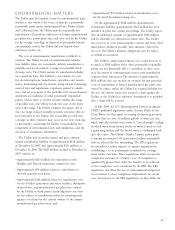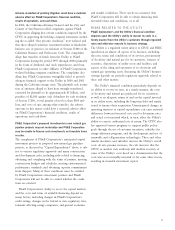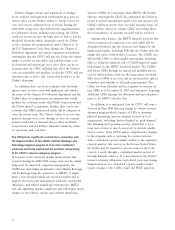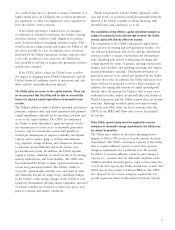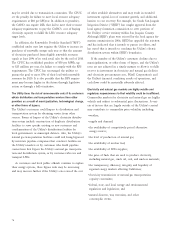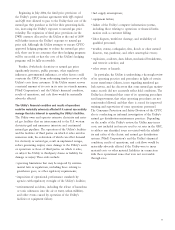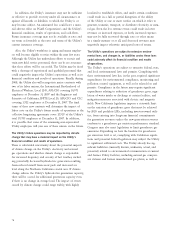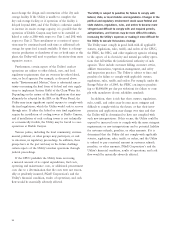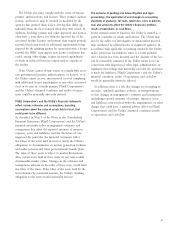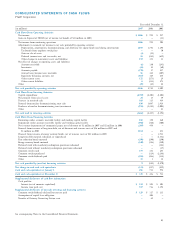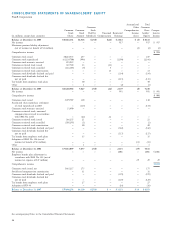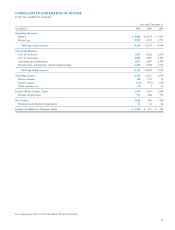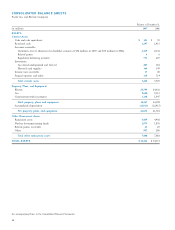PG&E 2007 Annual Report Download - page 80
Download and view the complete annual report
Please find page 80 of the 2007 PG&E annual report below. You can navigate through the pages in the report by either clicking on the pages listed below, or by using the keyword search tool below to find specific information within the annual report.78
In addition, the Utility’s insurance may not be suffi cient
or effective to provide recovery under all circumstances or
against all hazards or liabilities to which the Utility is or
may become subject. An uninsured loss could have a mate-
rial adverse effect on PG&E Corporation’s and the Utility’s
fi nancial condition, results of operations, and cash fl ows.
Future insurance coverage may not be available at rates and
on terms as favorable as the rates and terms of the Utility’s
current insurance coverage.
Also, the Utility’s workforce is aging and many employ-
ees will become eligible to retire within the next few years.
Although the Utility has undertaken efforts to recruit and
train new fi eld service personnel, there can be no assurance
that these efforts will be successful. The Utility may be faced
with a shortage of experienced and qualifi ed personnel that
could negatively impact the Utility’s operations as well as its
fi nancial condition and results of operations. Finally, during
2008, the Utility also will re-negotiate major contracts with
two of its labor unions, the International Brotherhood of
Electrical Workers, Local 1245, AFL-CIO covering 10,971
employees at December 31, 2007 and the Engineers and
Scientists of California, IFPTE Local 20, AFL-CIO and CLC
covering 1,922 employees at December 31, 2007. The fi nal
terms of these new contracts will determine the impact of
labor costs on the Utility’s future results of operations as the
collective bargaining agreements cover 12,929 of the Utility’s
total 19,785 employees at December 31, 2007. In addition,
it is possible that some of the remaining non-represented
Utility employees will join one of these unions in the future.
The Utility’s future operations may be impacted by climate
change that may have a material impact on the Utility’s
fi nancial condition and results of operations.
There is substantial uncertainty about the potential impacts
of climate change on the Utility’s electricity and natural
gas operations and whether climate change is responsible
for increased frequency and severity of hot weather, includ-
ing potentially decreased hydroelectric generation resulting
from reduced runoff from snow pack and increased sea
level along the Northern California coastal area. If climate
change reduces the Utility’s hydroelectric generation capacity,
there will be a need for additional generation capacity even
if there is no change in average load. The impact of events
caused by climate change could range widely, with highly
localized to worldwide effects, and under certain conditions
could result in a full or partial disruption of the ability
of the Utility or one or more entities on which it relies to
generate, transmit, transport, or distribute electricity or natu-
ral gas. Even the less extreme events could result in lower
revenues or increased expenses, or both; increased expenses
may not be fully recovered through rates or other means
in a timely manner or at all, and decreased revenues may
negatively impact otherwise anticipated rates of return.
The Utility’s operations are subject to extensive environ-
mental laws, and changes in, or liabilities under; these laws
could adversely affect its fi nancial condition and results
of operations.
The Utility’s operations are subject to extensive federal, state,
and local environmental laws and permits. Complying with
these environmental laws has, in the past, required signifi cant
expenditures for environmental compliance, monitoring and
pollution control equipment, as well as for related fees and
permits. Compliance in the future may require signifi cant
expenditures relating to reduction of greenhouse gases, regu-
lation of water intake or discharge at certain facilities, and
mitigation measures associated with electric and magnetic
fi elds. New California legislation imposes a statewide limit
on the emission of greenhouse gases that must be achieved
by 2020 and prohibits LSEs, including investor-owned utili-
ties, from entering into long-term fi nancial commitments
for generation resources unless the new generation resources
conform to a greenhouse gas emission performance standard.
Congress may also enact legislation to limit greenhouse gas
emissions. Depending on how the baseline for greenhouse
gas emissions level is set, complying with California regula-
tions and potential federal legislation may subject the Utility
to signifi cant additional costs. The Utility already has sig-
nifi cant liabilities (currently known, unknown, actual, and
potential) related to environmental contamination at current
and former Utility facilities, including natural gas compres-
sor stations and former manufactured gas plants, as well as



